LIVE BLOG: AMD's Fusion Developer Summit 2012 Keynote
Live from Bellevue, Washington at AFDS 2012.
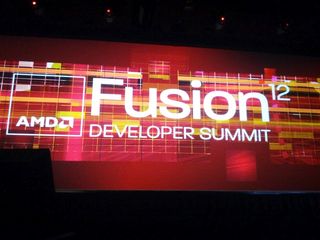
8:59 We're seated and ready in the front row waiting for the show to get started.
9:01 Any time now. We're told to silence all our mobile devices.
9:04 A reel of video is now playing about heterogeneous computing. That's going to be the focus here at AFDS.
9:05 Lisa Su takes the stage, the SVP and GM of global business units.
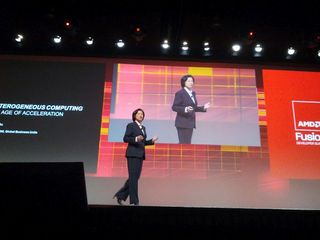
She's talking about sharing, networking knowledge about heterogeneous computing. The age of convergence through the cloud. AMD sees heterogeneous computing as the one to lead the charge both in hardware and software. "APUs, we believe this is the next generation of computing... the only way to change the game is to take the CPU and GPU and put them together the best way possible... we're betting the company on APUs."
Shipped over 40 million APUs to date. Trinity is next, 2x performance per watt of Llano. 56 percent more graphics compute. 12 hours battery life. The key is to make the APU as easy to program for as CPUs. "The bottleneck is in the software."
Stay on the Cutting Edge
Join the experts who read Tom's Hardware for the inside track on enthusiast PC tech news — and have for over 25 years. We'll send breaking news and in-depth reviews of CPUs, GPUs, AI, maker hardware and more straight to your inbox.
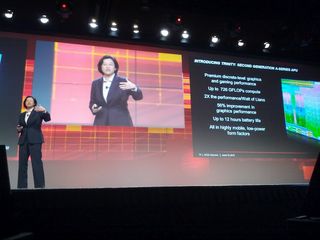
Twice as many developers in 2012 than 2011.
9:17 Manju Hegde, CVP of Heterogeneous Computing and John Taylor, general product manager, take the stage. Giving a big rundown of what to expect over the next couple of days. It'll be more than just AMD -- there will be talks from Adobe, Gaikai, and more.
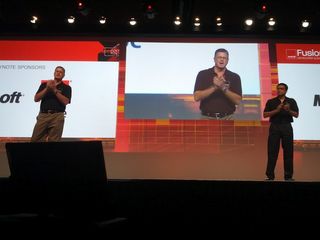
9:22 Tom Malloy of Adobe takes the stage. He's going to talk about heterogeneous computing at Adobe. Today's question: How do we attract mainstream developers?

CS6 ships with many new GPU features. First up for demo is the blur gallery. Now a demo of how to create a shallow depth of field in Photoshop. All real time simulated film blur, a bit like bokeh. Totally real time, no need to wait for any processing time.
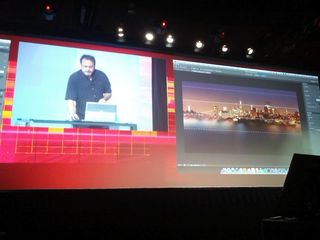
9:30 Malloy is back and telling us why they made these GPU features: Performance goal; Portability to different platforms. Next demo is for Premiere.
Now a demonstration on a 15" MacBook Pro... with an AMD GPU. Sadly, this won't apply to the new MacBooks with the Kepler GPU. Playing 4 streams of HD video, with real time color correction.
Again, the same performance, portability, and development model for Premiere CS6's GPU compute integration.
CinemaDNG to OpenEXR conversion also uses GPU compute, but no demo because "watching a video converter is like watching paint dry." Yes, we're sure it is, but the GPU makes it dry a lot faster.
Malloy gives the numbers: Mainstream developers still aren't into GPU compute yet. He calls GPU programmers "ninjas".
Citing "Innovator's Solution", right now there is a performance surplus in terms of there now being more system capability than what the customer needs right now. Over time, we get more power but our needs aren't growing as quickly.
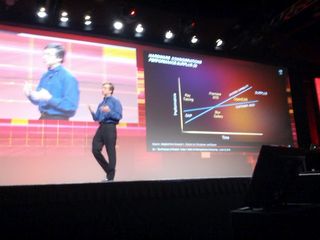
Adobe's claims:
Claim 1: Hardware vendors will deliver a performance surplus. There will be performance targets and they'll always be going further. This will attract mainstream developers.
Claim 2: A unified address space will enhance portability for mainstream developers.
Malloy is giving an old history story about the efforts needed to port Illustrator from the Mac to Windows, which was very hard with memory constraints going to the PC. It's that 640K. It took until 1997 until Windows had a comparable version to the Mac.
The debate is up: OpenCL vs Cuda. Malloy says that both are interesting, but OpenCL is open. The bottom line is that both are too low level for the mainstream developer. Abstraction layer is too low.
"This debate is interesting to ninjas, but not to mainstream developers. What we need is a higher level of abstractions."
That's claim 3: We need higher level standards to get the mainstream with better languages and tools.
Claim 4: Those who invest the most in tools can win the hearts and minds of developers. We surmise that this is where AMD wants to be.
And that's it for Tom Malloy from Adobe.
9:57 Phil Rogers, corporate fellow at AMD, and focuses on heterogeneous computing, takes the stage. He's talking about HSA, or heterogeneous systems architecture. "A year ago it was a dream, but now it's here."

"Today most parallel code runs on CPU, which is built for scaler work. This wastes power."
Phil Rogers sums up Adobe's Malloy's presentation as saying, "Today... it's too hard!" to get GPGPU going. Adobe gave a wishlist: top is a unified address space. Easier to debug and profile. Easier to debug.
Now it's all about HSA, which will bring things to the mainstream developer. 2011: physical integration. 2012: optimized platforms. 2013: architectural integration. 2014: system integration. This is the roadmap to HSA. See his slide for more:
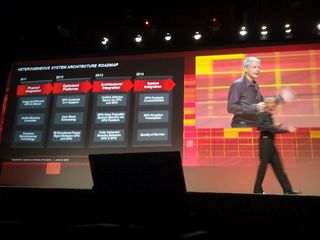
HSA bring ALL the processors in the system into Unified Coherent Memory. It will be power efficient; easy to program; future looking. It will be on an established technology foundation, which makes it low risk. It's an open standard "I can't express how important this is... this build standards." Industry support.
HSA and its Libraries are to solve the problems and challenges faced before with parallel programming.
Application areas with abundant parallel workloads:
natural touch UI and gestures
biometric recognition - no need to use passwords
augmented reality - HUD and overlays
content everywhere - any device
beyond HD experiences - streaming media, codecs
audio/video content management - managing your media collection.
Now a demonstration of face detection using the Mona Lisa as an example.

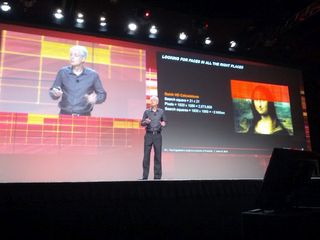
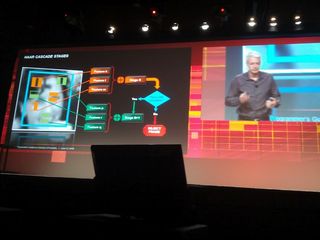

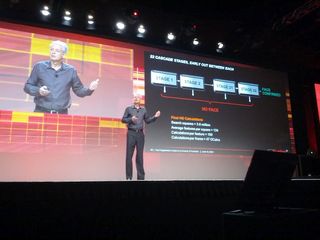
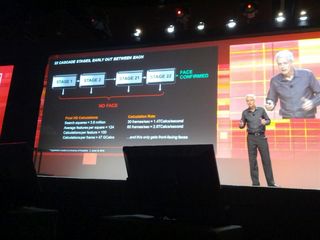
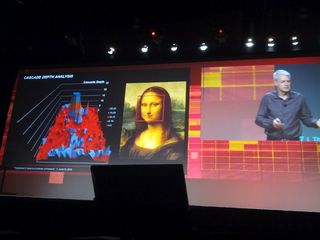
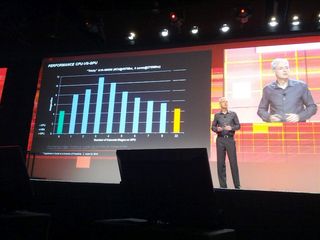

HSA can also benefit servers too.
HSA Bolt is a parallel primitives library for HSA. It supports both OpenCL and C++AMP. This is a single source code base for CPU and GPU.

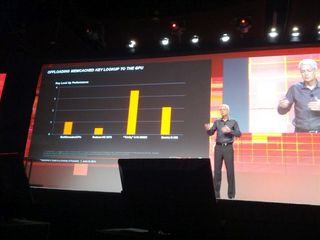
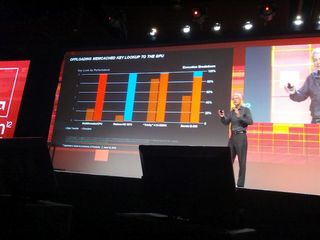
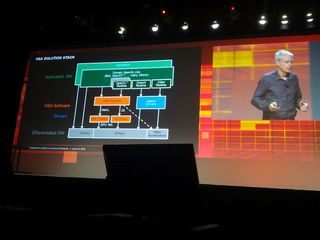
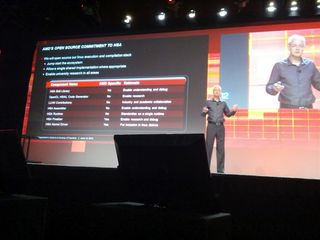
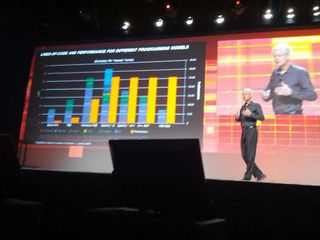
Rogers is also announcing the HSA Foundation - a non-profit standards body that will own the development and evangelization of HSA. It's basically to make HSA programming and development as easy as possible. AMD has given the HSA draft with specs for Programmer Manuals, Hardware and Software specs. It will be on Linux too.
One of the initial founders: ARM. Jem Davis, VP of Technology takes the stage.
10:34 Davis takes the stage. He jokes about all the speculation about acquisitions and such. But nope, it's all about HSA partnerships. HSA and ARM are a "natural fit" and Davis stresses that HSA Foundation will be separate from AMD. ARM must feel fairly comfortable, but they are the leader in mobile right now. ARM is totally onboard with the focus on energy efficiency. "For us it's all about energy" in smartphones to servers.
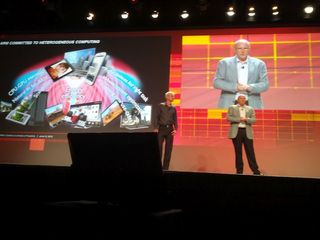
10:41 Next HSA founder: Imagination Technologies. Krishna Yarlagadda takes the stage. He's now talking about how computing/processing has gone from satellites and now to your phones, and then one day "inside" you.
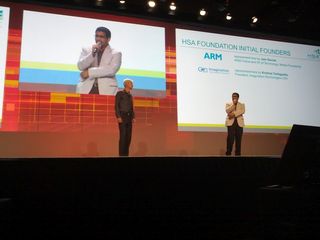
10:44 Next: MediaTek. K. Lawrence Loh, president of MediaTek USA. One of the largest providers of SoC, digital home entertainment systems. They hope HSA will make lives better.

10:46 Texas Instruments. Matthew Locke, director of Linux Development Center. "The key is not hardware, but driving the software adoption."
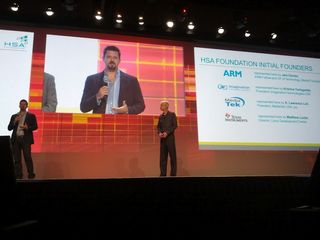
10:47 Manju comes back to talk about AMD's role as founder. "We introduced Fusion last year, but that's just the beginning. Soon we'll have Trinity." He was at Nvidia and tried to do GPGPU with 2 chips. Now he's at AMD with just 1 chip.

All about Silicon IP to Software Developers. www.hsafoundation.com
Manju says that the A in AMD stands for Audacious!
And that's it for now. Stay tuned for another live blog tomorrow!
-
Soul_keeper It'd be nice to see mention of video acceleration in linux (xvba/libva support) and kernel 3.4.x support.Reply
I'd welcome a complete rethink or renewed commitment to linux feature support. -
DRosencraft Soul_keeperIt'd be nice to see mention of video acceleration in linux (xvba/libva support) and kernel 3.4.x support.I'd welcome a complete rethink or renewed commitment to linux feature support.Reply
They may do it, but not likely they'll make any mention of it. It isn't a very big part of their current or future business, so I doubt they'll make time to mention it even if they actually do it at all. -
wiyosaya For the time being, I've stopped listening to AMD's bravado. When they have parts other than APUs back on the market that meet their promises, I may start listening again.Reply -
A Bad Day Looks at some of the recent gamesReply
Yeah, parallel computing has a long way to go. I wish the developers luck. -
ltdementhial it's all about the dozer's...when do we have an AM3+ SB-IV Killer...and i don't say an: Well the 8150 is well suited and it can compete very well with th 3770k blah blah blah.Reply
i want a: this new FX cpu is the "2500k" of AMD Great Price, Bigerg performance, overclock maniac...like those old day's when i used to brag around my Athlon 64 FX-51 2.2 that thing served me very very well...a TRUE FX. -
gilgamex ltdementhialit's all about the dozer's...when do we have an AM3+ SB-IV Killer...and i don't say an: Well the 8150 is well suited and it can compete very well with th 3770k blah blah blah.i want a: this new FX cpu is the "2500k" of AMD Great Price, Bigerg performance, overclock maniac...like those old day's when i used to brag around my Athlon 64 FX-51 2.2 that thing served me very very well...a TRUE FX.Reply
There is so much more to this than just BD man. You have to create developers who get on board with other aspects of content creation and core utilization. GPU acceleration n such. The future isn't BD really, not even PD, Steamroller will be a great step up but AMD is shooting for much bigger plans.
Nvidia made huge strides with their CUDA development, great Quadro driver support and Beastly Tesla cards. Parallelization is the key in workloads, making the use of GPU/CPU together more efficient and powerful is in AMD's vision their bread n butter. Also, Nvidia doesn't have a CPU chip to contend with at all.
Most Popular





